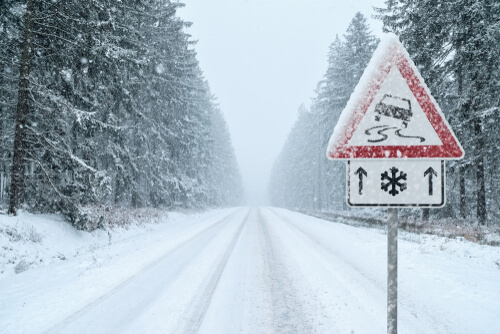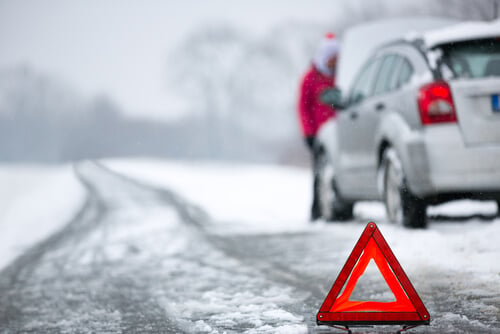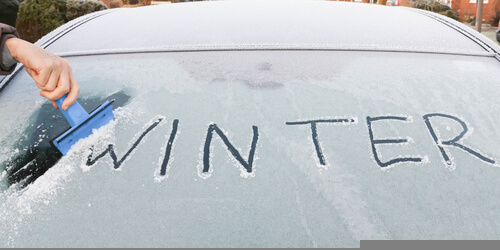
Reading Time: 6 minutes
As the frost sets in, winterize your car to ensure every holiday journey is safe and snug. Trust Nationwide AT for all your winter travel needs.
Winterizing your car is when you take steps to prepare the car for the harsh weather conditions that can damage certain parts of the vehicle and the way it functions in below-zero temperatures.
As we head into the colder months, it is time to start thinking about winterizing your car. Why? Because winter driving conditions pose a threat to your car with roads covered in ice and snow. While you as a driver should be prepared to drive in winter, your car also needs to be ready to handle extreme weather. Winterize your car before the winter season takes a hold of our road conditions and stay safe.

Pre-Winter Car Service
Before the winter wraps its icy fingers around our country, it’s a good idea to perform a pre-winter car service (winterize your car) to include the following:
- Check all cables, wires, spark plugs, belts, and hoses. Of course, these parts can be damaged at any time of the year, but the cold weather can see you be stranded on the side of the road deep in the snow.
- Inspect your brakes. Your car and its brakes don’t really hurt the brakes, but by having them tested, you can rest assured that you will have optimal performance when the roads are sleek and cold.
- Maintain your cooling system by keeping a range of 50/50 to 70/30 on antifreeze to water. It is a good idea to get advice from a professional technician who will advise you on the best antifreeze for your car. The purpose of using a specific coolant-to-water will help prevent potential freezing and corrosion.
- Ensure you have the right battery. When the temperature drops, you decrease the efficiency of your battery, and as a result, it takes more power to start the car. When a car battery is bad, you will experience more breakdowns. Opt for a battery of more than 600 CCA.
- Install winter tires. Although many people use all-season tires, even in winter, it will not offer the level of protection in those conditions. Bridgestone has a helpful guide to choosing snow tires.
- Maintain the pressure levels in your tires. Depending on where you live, you may lose or gain up to one pound for every 1-degree change in ambient temperature. You will find your manufacturer’s recommended tire pressure on a sticker inside the driver’s side door jamb and it should also be in the owner’s manual. This is a crucial aspect to winterize your car.
Prepare for Winter Driving
- Prepare for winter driving by checking the forecast. When the temperatures change, your driving ability and tire traction can be affected by slippery roads.
- Install new window wipers for winter. Winter wipers are equipped with rubber to keep eyes from collecting on the blades.
- Fill up the washer fluid so that you can regularly wash the windscreen.
- Winterize your car safety kit. If you’re heading off on a road trip, be sure to take along a roadmap, especially if you’re heading out in snowy conditions.
- Preparation is key to winterize your car. Spray a mixture of 1:3 water and vinegar onto your windows before the cold temperatures set in. This will help reduce the amount of ice and frost buildup on your windows, and you should be able to scrape the rest off easily. Never pour hot water on cold windows.
- Wash your car. Apart from the joy of driving a shiny, clean car, it is an important step towards winterizing your car. can also help extend your paint job and ensure the mechanical components remain in good working order. The elements – in addition to dusty and salty road conditions – can cause the paint to erode, leaving your car looking dull. When rust builds up, it can result in fluid leaks and engine malfunction. Be sure to give your car a good wax job to help liquids roll right off the surface. Our car cleaning hacks will help keep your car sparkling clean.
- Flush your heater to ensure your personal comfort on long, cold drives while you winterize your car.
Download our Car Winterization & Road Trip Safety Kit and print an extra copy to keep in your glovebox ahead of your seasonal travels.

Winter Driving in Snow and Ice
Whether you’re a brand new driver who just bought your first car or you recently moved from an area where there’s no snow to a winter wonderland, these tips should come in handy. Learning to drive in snow is a key to winterizing your car. Severe weather is dangerous to drive in, even if you are experienced, and should ideally be avoided at all costs. But if you really have to drive in the snow, you can use these tips to keep you safe.
- Learn how to use your car’s driven wheels. Vehicles have different driving characteristics dependent on their driven wheels, for example, FWD, RWD, AWD, and 4WD. Your most important task ahead of driving in snow and ice is to understand your car’s nuances based on the driven wheels. (It’s a good idea to learn how to use your car’s ADAS, too!)
- Test your steering inputs, acceleration, and braking. Road conditions can change unexpectedly, and it is safer to drive in cold weather than in freezing and wet conditions. Look for an empty stretch of road on which you can test your steering inputs, acceleration, and braking.
- Stick to a following distance of six to ten seconds when you drive on snow-covered roads, and apply smooth, gentle pressure on the brakes and gas when the roads are slippery. Keep an eye on any signs of loss of tracking when you brake, accelerate, or corner.
Are you Ready for a Winter Road?
- Keep your eyes on the road. You can avoid sudden braking by attentively scanning the road ahead so that you’re able to allocate ample time to brake or make a move.
- Listen to the ABS. The anti-lock braking system (ABS) on some cars will pulsate in the pedal when you brake on snow. When that happens, keep your foot firmly on the pedal and don’t let up on your brakes.
- Accelerate gently. When you accelerate on wet or icy roads, apply gentle pressure to the gas and take your time to reach safe cruising speed and to prevent the driven wheels from losing traction and spinning out of your control.
- Avoid quick jerks of the steering wheel when you drive on snow or ice, as that could lead to oversteering and understeering. Never slam on the brakes or overcompensate when you steer. Instead, steer into a skid and gently accelerate in order to regain control of your vehicle.

Takeaways
These tips should help you stay safe if you have to drive on wet, slippery roads in winter. If you’re not 100% confident that you can handle your car during your holiday travels, rather consider flying and shipping your car to its destination. Trekking up North? Check out our RV winterization cheat sheet.
Nationwide Won’t Leave You in the Cold
Don’t let winter weather put a freeze on your travel plans. Ensure your car is winter-ready and explore Nationwide Auto Transportation’s suite of services to keep your holidays running smoothly:

- Secure your peace of mind with our reliable Car Shipping services.
- Opt for Open Car Transport for a cost-effective solution to your shipping needs.
- Protect your prized vehicle against the elements with our Enclosed Auto Transport Service.
- Choose convenience with Door-to-Door Auto Transport—we come to you, no matter the weather.
- For the big movers, our Heavy Duty Shipping handles your larger-than-life transport needs.
- Planning an RV adventure despite the chill? Our RV Shipping services have you covered.
- Need it now? Ask about Same Day Car Shipping for when time is of the essence.
- For those in Mississippi and Oregon, check out our convenient Pickup Locations and Oregon Pickup Locations.
- Ready to roll? Start with a Quote Request and let’s get your vehicle winter-ready and where it needs to be—safely and on time.
Click, ship, and sip your hot cocoa while we handle the winter woes. Contact Nationwide Auto Transportation today and take the first step towards stress-free holiday travels!



